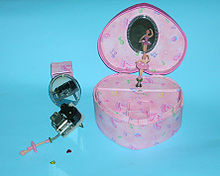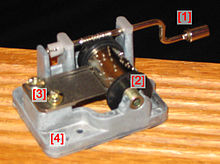Talk:Music box
| This article is rated C-class on Wikipedia's content assessment scale. It is of interest to the following WikiProjects: | |||||||||||
| |||||||||||
Grammar mistake
Hi
I am not a native English speaker, but it seems to me that in the example below, the sentence should start with 'There were' rather than 'There was':
There was many variations of large music machines, usually built for the affluent of the pre-phonograph 19th century. Some were called the Symphonium, others were called the Concert Regina Music Box machine. Both variations were as tall as a grandfather clock and both used interchangeable large disks to play different sets of tunes. Both were spring-wound and driven and both had a bell-like sound. The machines were often made in England, Italy, and America, with additional disks made in Switzerland, Austria, and Prussia. Early "juke-box" pay versions of them existed in public places also. Marsh's free Museum and curio shop in Long Beach, Washington State (USA) has several still-working versions of them on public display. The Musical Museum, Brentford, London has a number of machines[1] The Morris Museum in Morristown, NJ, USA has a magnificent collection, including interactive exhibits. In addition to video and audio footage of each piece, the actual instruments are demonstrated for the public daily on a rotational basis.[2]
Aethalides (talk) 07:03, 15 April 2013 (UTC)
Links to archives.
Would be useful links to archives of recorded musical boxes, if there is any.
I dont see how placing a link to http://studentpages.scad.edu/~jgardn24/musicbox5.html is an advertisement or anything like that. It's an interactive website that I'm in no way affiliated with, that shows the inner workings of a music box and how one works.
24.222.215.47 19:28, 4 November 2006 (UTC)
I'd like an explanation as to why my link is being removed!
24.222.215.47 21:33, 4 November 2006 (UTC)
Tsukini kawatte!
Does the famous Sailor Moon Densetsu locket exist in mechanical form (made by Sankyo or anybody else)? I have the usual electronic tone-based version (the luxury one with metallic casing) but it is still not the "real thing". I would get a peg-based one, if it is affordable. 82.131.210.162 19:38, 11 February 2007 (UTC)
Whitney Music Box
I've added the Whitney Music Box to show how animation can demonstrate musical thirds, but as it is a virtual music box, I felt that the information would be best served on this page.
Title
I'm from the UK and I've never heard the usage musical box, only music box. —Preceding unsigned comment added by 86.144.145.25 (talk) 02:18, 19 November 2010 (UTC)
Polyphon
There is a separate entry for polyphon which should be listed on this page somewhere, but I am not sure where. Perhaps an edit of the "evolving production" section could include this variant? That section needs tidying anyway. Elriana (talk) 20:27, 26 February 2014 (UTC)
This article needs the addition of info on two modern/recent musicbox developments.
Hello.
1) I notice there is an almost complete lack of information in the article about the current new type of music box, namely the punched-paper-tape music box, also called the "D.I.Y. musicbox". I suggest someone write up info about that new development in the musicbox world. Do you need ME to do that? Who wants to cooperate with me on writing-up that info? I don't know what authority to talk with, about this. If anyone has discussion on this, feel free to contact me at [email protected], as I know a few things about this type of musicbox. One type (the most popular, due to its low price) is manufactured by "Kikkerland". These "D.I.Y" or "punched paper-tape musicboxes" are sold on eBay. YouTube videos of them are available, for example here: https://www.youtube.com/watch?v=PHiW_krWgow
2) And another development is the electric musicboxes. Both the "D.I.Y." (punch your own tune into a paper tape) and the (pinned-drum) type of musicboxes are now available as electric-motor-driven musicboxes (in addition to the spring-wound and hand-cranked types of musicboxes).
I really think SOMEONE should add these types of info, RECENT developments, in this area, musicboxes. I do not feel qualified, myself, to do it all, myself. So I would welcome a co-writer or an authority to provide significant guidelines.
Artpitkin (talk) 08:47, 12 January 2015 (UTC)
What about the Wintergatan Marble Machine?=
http://www.wired.co.uk/news/archive/2016-03/02/marble-machine-video — Preceding unsigned comment added by 96.28.166.3 (talk) 18:20, 24 May 2016 (UTC)
External links modified (February 2018)
Hello fellow Wikipedians,
I have just modified one external link on Music box. Please take a moment to review my edit. If you have any questions, or need the bot to ignore the links, or the page altogether, please visit this simple FaQ for additional information. I made the following changes:
- Added archive https://web.archive.org/web/20060110175104/http://www.mbsi.org/glossary.php to http://www.mbsi.org/glossary.php
When you have finished reviewing my changes, you may follow the instructions on the template below to fix any issues with the URLs.
This message was posted before February 2018.
{{source check- If you have discovered URLs which were erroneously considered dead by the bot, you can report them with this tool.
- If you found an error with any archives or the URLs themselves, you can fix them with this tool.
Cheers.—InternetArchiveBot (Report bug) 04:08, 9 February 2018 (UTC)
Uncited material in need of citations
I am moving the following uncited material here until it can be properly supported with
Extended content
|
|---|
|






